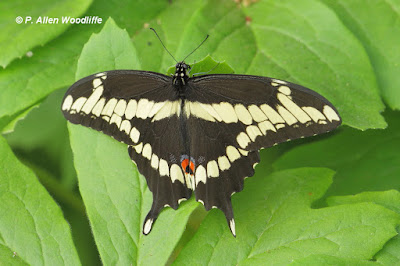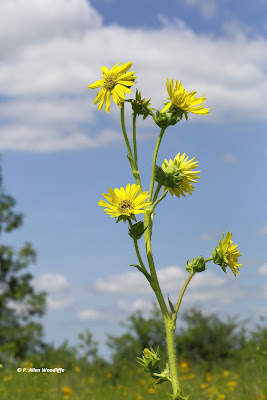Last Saturday I had the privilege of meeting a group of about 20 enthusiastic members of the Field Botanists of Ontario at the Bickford Oak Woods Conservation Reserve in west central Lambton County. The outing was planned several months in advance, and the main target species from a botanical standpoint was to see the one and only place in Canada where Swamp Cottonwood (Populus heterophylla) occurs. It was first discovered by the trio of Gerry Waldron, John Ambrose and Lindsay Rodger back in 2002 while they were doing a vegetative inventory in the early stages of this site becoming a Conservation Reserve. It isn't an easy species to find, even when you know where it occurs at this site. One has to access the spot through a planted prairie, then along the woods for several hundred metres, and eventually following an overgrown logging trail for several hundred more metres. It is then necessary to strike off through the woods, cross a muddy creek and then venture another couple of hundred metres to find the buttonbush swamp which has a number of stems of this rare tree. The FBO members were eager, so off we went.
On the way to the spot where the cottonwood grows, we came across a number of interesting species. This first one, Whorled Milkweed (Asclepias verticillata) was a new one for some of the members.
The wet spots along the trail, of which there were many, had a few stems of this Square-stemmed Monkey Flower (Mimulus ringens).
We came across a Giant Swallowtail butterfly. In this area, one of the main plants that the larvae of the Giant Swallowtail survives on is Prickly Ash (Xanthoxylum americanum). As one might guess by its name, it is a thorny species, and not one that is fun to hike through. Seeing this beautiful large butterfly was a bit of compensation for the time spent shortly after trying to get through the Prickly Ash thickets without getting too scratched up.
At one point along the creek and floodplain area there were some of these Cardinal Flower (Lobelia cardinalis) in fine shape. It isn't a rare species by any means, and in fact is quite widespread across southern Ontario and beyond, but the brilliant scarlet colour of the flowers is always a treat to come upon.
Most oaks at this conservation reserve have been logged at one time or another. There are very few large examples remaining. However this White Oak (Quercus alba) is relatively large. Probably because it is growing right along the edge, and has lots of large lower branches, it was less valuable from a timber standpoint at the time the site was logged half a century or more ago.
As mentioned, the intended target species for this hike was the Swamp Cottonwood. This next image shows what the site looks like in the spring, with lots of variable sized trunks of this rare species growing in standing water.
And this is the characteristic leaf: it is large for a cottonwood, has a heart-shaped base, and the leaf stem is round, not flattened as most Populus species are.
This is the happy group of FBO members, in front of a cluster of Swamp Cottonwood tree trunks.
After achieving our target of seeing the Swamp Cottonwood, we returned to the parking lot and had some refreshments. With about 4 hectares of planted prairie adjacent to the parking lot, we took a bit of time to explore the species present. Big Bluestem, a.k.a. Turkeyfoot (Andropogon gerardii) is the most common grass in most tallgrass prairies.
Gray-headed Coneflower (Ratibida pinnata) is often quite abundant.
False Sunflower(Heliopsis helianthoides) is one of the many sunflower types found in a prairie.
Dense, or Spiked, Blazing-star (Liatris spicata) is probably one of the best known, iconic prairie wildflowers. It is a Threatened species in Ontario.
Compass Plant (Silphium laciniatum) is not common at all, but really stands out on a prairie.
Another Silphium species is Cup-plant (Silphium perfoliatum). The close-up of the paired leaves show the cup-like aspect which gives it its name.
Prairie Dock (Silphium terebinthinaceum) is another iconic tallgrass prairie species. The shovel-shaped leaves are clustered at the bottom of a tall, quite rigid stem that sometimes grows more than 3 metres high.
Tall Coreopsis (Coreopsis tripteris) is another rare prairie plant restricted to the tallgrass prairies of extreme southwestern Ontario.
Yet another member of the sunflower family that is common on the prairie is Tall Sunflower (Helianthus giganteus). It too often grows 3-4 metres high or even higher.
It was an excellent day, and with great weather right up until the end of the outing. Just as the last of us were packing up the vehicles, it started to sprinkle and there was the occasional rumble of thunder in the background. Before we got too far down the road, the rain came down in torrents.





















Thanks again for a great day out Allen, it's certainly not everyday that one gets to add a new tree to their Ontario List. Perfect timing for the downpour!
ReplyDeleteThanks, Patrick....it was great to meet you and finally put a face to a fellow blogger!
Delete